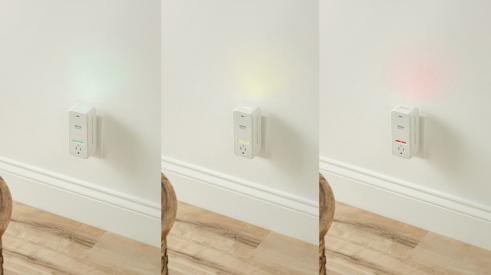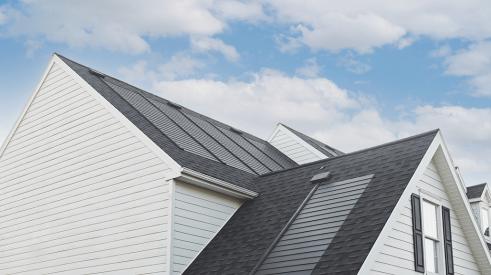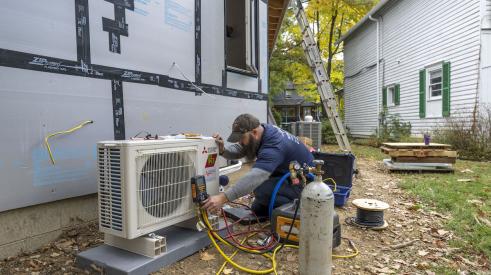Remember when all a window had to do was fill a hole in the wall and look reasonably presentable? Actually, to get technical about it, the window is the hole and not what you put in it, or at least that was the understanding for most of its history.
Human dwellings, at least in temperate climates, initially had few if any holes in the walls, except the one you used to come in and out. But light was needed and someone somewhere along the way began building walls with holes in them.Someone else figured out how to fill those holes with animal skins, scraped and stretched to a semi-translucent state, or in some cultures, paper. The use of glass goes back to Mesopotamia in 3,500 BC, but the Romans were the first to put it in windows, with frames of wood, iron, or lead.The building product we refer to as a “window”—what goes in the hole, rather than the hole itself—first came into widespread use in England in the early 17th century.
The Hole Thing
But a window is still a hole, and a “thermal hole” at that. It’s one of those places in the building where energy leaves or leaks. And it’s a biggie. Some research from a dozen years back suggested that even the most efficient windows are nowhere near as effective as a well-constructed wall in retaining energy. “Most windows are ten times less energy efficient than the wall area they replace,” wrote Paul Fisette, in Windows: Understanding Energy Efficient Performance in 2003.
What’s changed? What Fisette says about how windows work or don’t work when it comes to energy in the home remains true, but the difference is that today’s windows are better, meaning more efficient.
That efficiency is measured by the National Fenestration Ratings Council, a non-profit organization. The NFRC is, in its own words, “the only uniform, independent rating and labeling system for the energy performance of windows, doors, skylights and attachment products.”
The organization uses two criteria when determining window performance: U-Factor and Solar Heat Gain Coefficient. (See "How To Read the NFRC Label," which explains criteria on a label and shows consumers how to interpret what’s there.)
The Environmental Protection Agency uses NRCA ratings to award certain window products its Energy Star and its even more sought-after “Most Efficient” categories. A dozen years ago, when Fisette’s article appeared, Energy Star qualification criteria ranged from a U-Factor of 0.30 in Northern Climate Zones (roughly half of the U.S.) to 0.60 in the Southern Zone.
Fast forward to today, when changes in the window assembly, insulation, and glass have caused the EPA to up the ante onEnergy Star qualifications, as noted by Ohio manufacturer Sunrise Windows on its blog. Also, view a webinar on Energy Star 6.0, courtesy of Quanex Building Products.
Energy Obsessed
Does it make that big a difference? Micro and macro, the answer is yes. The potential effect is huge. Commercial and residential buildings account for about 40% of U.S. energy consumption. Those buildings make up the largest piece of the total U.S. energy consumption pie chart, consuming more energy even than manufacturing. So if millions of windows were replaced with window units more efficient by a third, or better … well, to get an idea, you can view an EPA chart that shows how much would be saved, on average, by replacing a single-pane glass window or even double pane clear glass replacement windows with today’s more efficient window units.
Now imagine today’s double pane windows, which with gas insulation, coatings, etc. are that much more efficient.
Homeowners are not indifferent to this argument. They want a more comfortable house and a lower energy bill. The Energy Star "Partner Resource Guide" cites 2012 survey data showing that when homeowners bought a particular window brand because of label or product claim, the largest number—45%— did so because it was Energy Star Certified. That probably doesn’t mean they could explain the specifics behind that label right off the bat, or what something called “fenestration” is. What it does mean, though, is that they care a lot about how well that window will retain energy.
Related Stories
Working Toward Affordable, Resilient Homes
A new natural disaster protection act from NAHB aims to support hazard mitigation projects
Client Design Choices in the Time of Social Media and AI
Social media speeds up the trend cycles, and now artificially created images are falling into homeowners' hands
Indoor Air Quality Gets Smart
A home's air quality can now be cloud connected and fully automated with this innovative product
Webinar: From Disjointed Design to Cohesive and Efficient—The New American Remodel 2023
Access the recording for the first The New American Remodel webinar held on March 8 at 2 pm CT
5 Standout Energy-Efficient Products Spotted at IBS 2023
See what this green remodeler recommends from the show floor
Innovative Products: GAF Energy Timberline Solar Shingles
GAF Energy’s latest innovation has taken the solar world by storm
Detailed Design: Benefits of Biophilism
See the details our Model ReModel contractors chose to infuse nature into their ADU
Heat Pumps Now Required in Washington New Construction
Washington is the second state to require heat pumps in an effort to electrify homes











